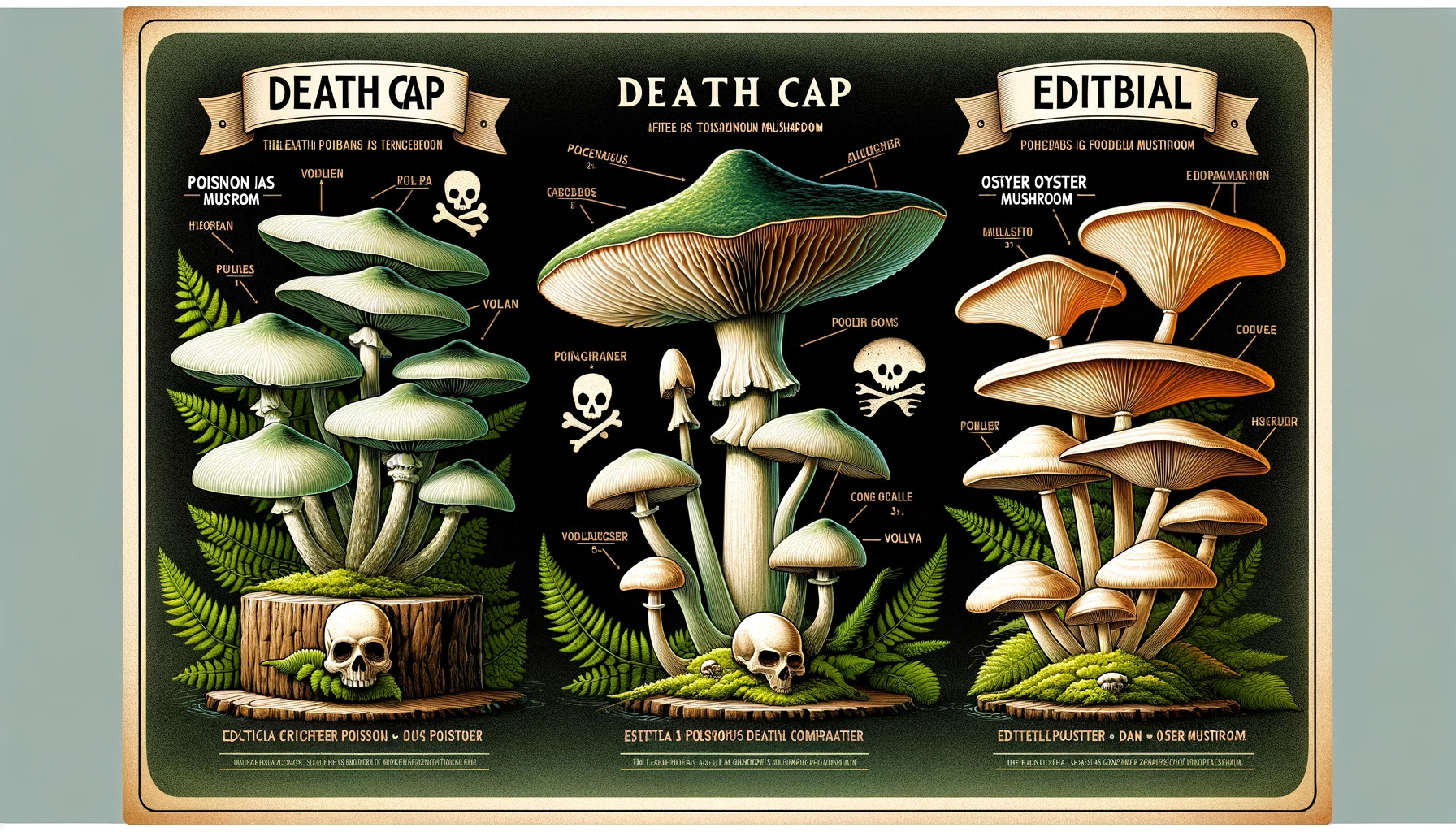Mushrooms, with their diverse forms and ecological roles, offer a world of fascination and caution. Among the myriad species, two notable ones stand out due to their striking differences and significant impact on human life – the Poisonous Death Cap and the Edible Oyster Mushroom. This comprehensive guide aims to provide an in-depth understanding of these two distinct fungi, their identification, habitats, and the crucial distinctions between them.
The Poisonous Death Cap (Amanita phalloides)
The Death Cap mushroom, infamous for its lethal toxicity, is a species every forager should recognize and avoid.
Identification
- Appearance: This mushroom features a cap that can be 5-15 cm wide, with colors ranging from green to yellow. The cap surface is smooth and can be sticky when moist.
- Gills and Stem: The gills are free from the stem and are white. The stem is also white, with a ring and a bulbous base, enclosed in a volva – a distinct cup-like structure.
- Spore Print: Its spore print is white, a characteristic feature of the Amanita genus.
Habitat and Distribution
- Habitat: The Death Cap is typically found in wooded areas, especially under oak, chestnut, and pine trees.
- Distribution: Originally native to Europe, this species has spread globally, often through the transplantation of its host trees.
Toxicity
- Toxins: The Death Cap contains amatoxins, which are deadly even in small amounts. These toxins attack the liver and kidneys, leading to severe organ damage or failure.
- Symptoms and Treatment: Symptoms include stomach pain, vomiting, and diarrhea, and can take 6-24 hours to appear. Immediate medical attention is critical, as there is no known antidote.
The Edible Oyster Mushroom (Pleurotus species)
In stark contrast to the Death Cap, Oyster Mushrooms are highly prized for their culinary value.
Identification
- Appearance: Oyster Mushrooms have a distinctive fan or oyster-shaped cap, ranging in color from white to dark brown.
- Gills and Stem: The gills descend along the short, sometimes off-center stem.
- Spore Print: The spore print of an Oyster Mushroom is usually lilac-grey.
Habitat and Distribution
- Habitat: These mushrooms typically grow on the sides of living or dead hardwood trees.
- Distribution: Oyster Mushrooms are found worldwide and are one of the most commonly cultivated edible mushrooms.
Culinary Use and Nutrition
- Culinary Applications: Oyster Mushrooms are celebrated for their delicate texture and mild flavor, used in various dishes.
- Nutritional Value: They are a good source of protein, vitamins, and minerals, and have been recognized for their cholesterol-lowering properties.
Distinguishing Between the Two
Distinguishing between the Death Cap and Oyster Mushroom is vital for safe foraging:
- Cap Structure: The Death Cap’s cap is more traditional mushroom-shaped, while the Oyster Mushroom has a distinct oyster or fan shape.
- Volva: The presence of a volva at the base of the mushroom is a clear indicator of the Death Cap.
- Habitat: Oyster Mushrooms grow on wood, while Death Caps are typically found under certain trees in the soil.
Conclusion
Understanding the key differences between the Poisonous Death Cap and the Edible Oyster Mushroom is crucial for both amateur foragers and mushroom enthusiasts. While the Death Cap poses a significant danger due to its high toxicity, the Oyster Mushroom is a beloved edible species, widely used in culinary arts. This guide highlights the importance of accurate identification and respects the diverse roles these fungi play in our ecosystems. Whether you are a seasoned mycologist or a curious nature lover, appreciating and understanding these fascinating fungi is essential for enjoying their benefits and avoiding their perils.
FAQs
Q1: Are Death Cap mushrooms poisonous?
- A1: Yes, extremely. Even small amounts can be fatal.
Q2: How do I identify a Death Cap mushroom?
- A2: Look for a greenish-yellow cap, white stem, and a bulbous base (volva).
Q3: Can you eat Oyster Mushrooms?
- A3: Yes, they are edible and nutritious.
Q4: Where do Oyster Mushrooms grow?
- A4: Typically on dead or dying hardwood trees.
Q5: What do I do if I eat a Death Cap by mistake?
- A5: Seek immediate medical attention.
Q6: Are Oyster Mushrooms healthy?
- A6: Yes, they are rich in protein and nutrients.
Q7: Is there an antidote for Death Cap poisoning?
- A7: No, treatment is supportive care.
Q8: Can cooking make Death Caps safe to eat?
- A8: No, cooking does not remove their toxins.

Alex is a seasoned writer and researcher, specializing in psychedelic studies and mental health. Known for insightful and authoritative content, he combines extensive knowledge with a passion for exploring wellness and alternative therapies. Alex’s work is a trusted resource for readers delving into the world of mental well-being.


Leave a Reply